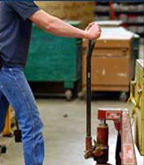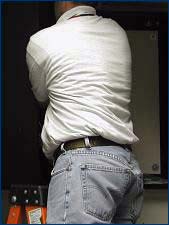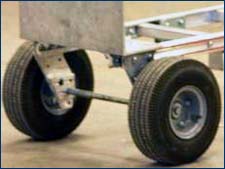Solutions for Electrical Contractors eTool
Materials Handling » Pushing, Pulling and Carrying

Electrical work involves moving materials around the worksite. Commonly, there is a central staging area from where supplies are distributed to separate work areas. This can involve pushing, pulling, and lifting materials, sometimes with the help of a hand truck or utility cart.
The following hazards may exist when employees transport materials around the worksite:
Potential Hazards

-
Assuming awkward postures such as reaching behind the body, bending forward and to the side, and twisting when pushing and pulling materials (Figure 1), may lead to muscle strain and spinal injuries.
-
Handles that arc too high or too low require extra force exertion.
Possible Solutions

-
Use transport devices, such as hand trucks and pallet jacks, and know the correct postures to maintain when using these tools.
-
Provide transport devices with appropriate handles. These handles should be in the power zone (Figure 2) when pushing and large enough to accommodate the entire hand. There should be no sharp edges or rough spots that could cut or pinch the employee's hands.
-
Avoid pulling when possible. Pushing generally takes less effort than pulling because your body weight is used to assist the exertion. Also, pulling a load often causes carts to run into the shins or ankles.
-
Use vertical handles instead of horizontal handles to allow employees of different heights to maintain neutral postures.
-
Do not stack materials on a cart higher than eye level so that you do not have to bend to the side to see around the load. Employees should be able to easily see over the top of the load.
-
Use stair-climbing hand trucks to transport materials up and down stairs.
-
Limit the weight of loads so the necessary pushing force is less than 50 pounds. The greater the force that is necessary to push the load, the greater the risk of injury.
Potential Hazards

-
Operating transport devices with improperly functioning wheels (Figure 3) makes moving materials more difficult than necessary.
-
Exerting more force to guide a hand cart with under-inflated or unevenly pressurized tires may put stress on an employee's arms, back, and legs.
-
Moving carts or hand trucks over bumpy, rough terrain or up and down stairs may expose employees to abrupt, jarring impacts which can cause shoulder and back strain.
Possible Solutions

-
Replace wheels when they become wobbly or uneven.
-
Select hand trucks or carts with pneumatic wheels (Figure 4) for moving things over bumpy, uneven terrain or up and down stairs.
-
Check the air pressure of pneumatic tires and fill them to the recommended pressure.
-
Use transport devices, such as hand trucks and pallet jacks, and know the correct postures to maintain when using these tools.
-
Provide employees with access to elevators or ramps so they can avoid stairs and bumpy ground.
-
Use powered hand trucks with stair-climbing and self-leveling abilities when stairs can not be avoided.
-
Develop good housekeeping practices to ensure that floors are clean so there is minimal resistance.
-
Wear shoes with good soles to maintain firm footing.
-
Reduce the size of the load you carry when going up and down stairs to reduce the force required to transport loads.
-
Use curb ramps that allow the employee to easily push the transport device over curbs.

